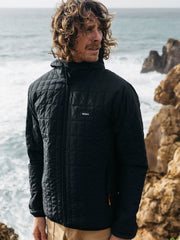Inês Ambrosio: A Modern Cyanotype Artist
23.03.21
4 min read
Words & Images by Inês Ambrosio
Profile photo by Mafalda Gomes
For those who don't know, what exactly is a cyanotype and how do you go about making one?
A Cyanotype, also known as “blue print” was one of the first ways of making a photographic image. Discovered by John Hershel and used by many photographers, artists and architects, among others, to create images. The chemicals for this light sensitive solution make the image go blue and although it is a very simple process in comparison with many other photographic ones, it was a massive discovery at the time and I believe is coming back to focus today for the beauty of its final colour. Blue brings melancholic and nostalgic feelings out. Also peaceful ones, similar to how the ocean makes us feel.
With all the modern technology available to us, what is it about this old analogue medium that you love and why did you choose to focus on producing work in this way?
For me photography has always been about the physicality of it, from the early days of my practice I have realised the importance of spending time creating an image. I experimented with many alternative and analogue processes and the blue print made me feel instantly connected with my biggest passion - surfing - and my favourite element - water – not only for it’s colour but also because of the process itself. Whether it is on a piece of paper, fabric or glass, the photographic object needs to be in contact with the sun, more precisely UV light, being then washed in water. For the few years I was studying Photography at the University of Brighton, Photography became the main focus of my life and surfing was left to a secondary priority. Today, I naturally found my place and balance in Cyanotype making.
Were you aware of the history of cyanotypes and the story of Anna Atkins before you started making work in this way? Or are there any other cyanotype artists that have inspired you?
Yes, since I’ve chosen an academic path, all my university work was intrinsically connected to the understanding of the medium history, to all the references and artists that have used or are using the process. That led me to try to understand where I stand with it: what is it bringing to my personal artistic practice. I think that in this sense it all came together as one, I was clearly attracted to this process by Its finished colour and the rest came along organically. Anna Atkins was a botanist and her father a friend of Fox Talbot, himself a scientist involved in the discoveries of other photographic processes, so she was clearly inspired by the people surrounding her as well as for her own passion for plants. She was a pioneer in cyanotype use, following John Hershel’s discovery of this process when trying to find a way to make copies of his notes.
A lot of your works focus on the sea, on plants, and on the natural world. Is there a particular message you're trying to get across in these images, or is it simply a showcase of the environment that you're drawn to?
I believe we are always walking towards our most authentic self. Art helps me as much as the ocean and surfing to find my balance. Nature, plants, the sea, are all my sources of energy and what I am most passionate about in life. So, in a way, I am clearly drawn to these and therefore they are reflected in my work. There is also a big part of me trying to understand the world and people in my life, which is reflected in my work as well. I am super connected to my family and to my feelings when creating a body of work, so they are a big part of my inspiration too.
You mention your connection to water in reference to much of your work. When did you first discover this connection, and what does the sea give you in your daily life?
I think the first memories I have of this connection with water are from when I was really young and would go to the beach with my family. They would all go to the water with me and my father would be the one staying there longer, teaching me about respecting the force of the ocean. He also bought me my first boogieboard, I even remember it had a dolphin on it! My favourite Barbie was also a diver and I’d spend hours playing with only that one, I didn’t care about the others. I grew up in Portugal and lived by the sea when I grew up. I would surf every day and spend hours at the beach, especially from around the time I was 14 and was doing arts in college.
The sea gives me so much in my daily life. Makes me feel balanced emotionally and physically when surfing; inspires me constantly; listens to me when I don’t want to speak with anyone else. Helps me always seeing the brightest side of things.
Who knows where my life and work will go towards to in the next few years? One thing I’m sure: Water and the blues will always be present for me.




















































































